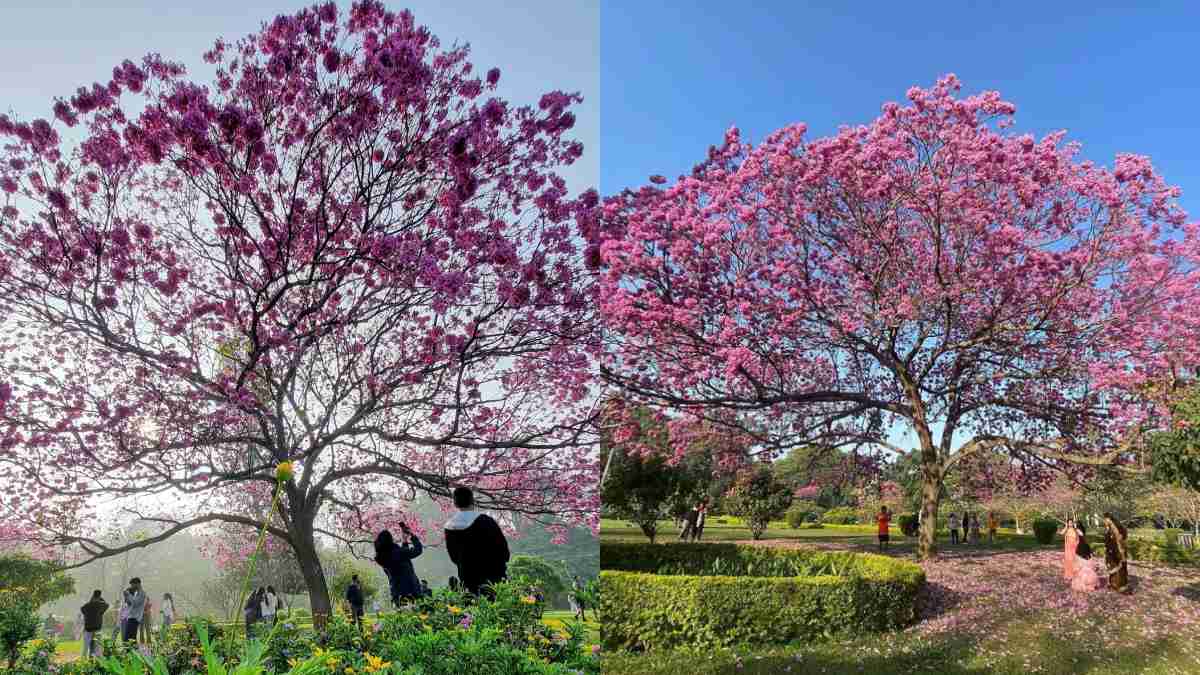It’s that time of the year in Bengaluru when the city transforms into a pink paradise. Picture driving down streets with trees bursting in pink blooms or taking a casual stroll in parks surrounded by dreamy pink flowers. That’s the delightful sight that defines Bengaluru in mid-January. Check out these snapshots from Bengaluru, resembling scenes right off a meticulously crafted Pinterest moodboard.
Got a chance to witness & click this with at least a million others there!! #CubbonPark pic.twitter.com/godtO66ctr
— Anurag Agrawal (@anurag0__0) January 14, 2024
From December to March, Bengaluru residents revel in the city’s annual Pinterest-worthy transformation. Despite the common misconception, the blossoms gracing the streets are not cherry blossoms. Instead, Bengaluru’s pink landscape owes its enchanting allure to two tree species: Tabebuia avellanedae and Tabebuia rosea. Known as pink trumpet trees, Tabebuia avellanedae and Tabebuia rosea hail from South America and were introduced to Bengaluru by British colonists. The British, with a penchant for ornamental exotic species, planted these vibrant pink trumpet trees in the city.
#cubbonpark ಅಲ್ಲಿ ಹಾದು ಹೋಗುತ್ತಿರುವ ಎಲ್ಲಾ ಜನರ ದೃಷ್ಟಿಯನ್ನು ಸೆಳೆಯುತ್ತಿರುವ ವೃಕ್ಷ 🙏🏻 #trees #photography#tabebuia #rosea pic.twitter.com/E6rrwa4XYm
— Santhosh R (@santhubasu) January 14, 2024
Horticulturists, tasked with enhancing Bengaluru’s green cover, played a crucial role in bringing these trees to the city. Kavya Chandra, a garden and plant expert, explained, “The trees were planted here by the horticulturists who were commissioned to enhance the green cover in Bengaluru. It is a combination of the efforts of the earlier rulers of Bengaluru including the British who allowed the flowers to bloom.”
It’s that time of year again…#bangalore #cubbonpark #FlowersOfTwitter #NaturePhotography pic.twitter.com/Xvct27WPim
— Aruna Nambiar (@ArunaNambiar) January 15, 2024
Beyond their visual appeal, the choice of these trees likely aimed to recreate a taste of the springtime the British colonists left behind.
Also Read: Your FASTTag Will Deactivate After January 31 If You Do Not Do This Update
British and German horticulturalists, such as James Cameron, superintendent of Government Gardens in the late 19th century, and Gustav Krumbiegel, who spearheaded horticulture in Bengaluru, imported trees from colonial territories, botanical gardens, and sites of botanical exploration worldwide,” explained Harini Nagendra, Director of the Research Centre at Azim Premji University, in an interview
Now at Mumbai, I really miss the stark pink Tabebuia blossom at #cubbonpark (pic HeritageBeku) 😞 @Vijaykarnataka @BangaloreMirror (Bengaluru, probably the #1 city in India) @venkteshbabu pic.twitter.com/7yo9PzmdbW
— Ranjeet Kate (@katranjeet) January 14, 2024
These trees undergo a transformation starting at the end of November when they shed their leaves, making way for small flower buds. The blooming process commences in December, revealing trumpet-shaped flowers, hence earning them the name ‘trumpet trees.’
Even as the era of British rule concluded, the Tabebuia trees persisted. In the 1980s, SG Neginhal, an Indian forest official and renowned horticulturist, played a pivotal role in solidifying their presence. Neginhal, along with dedicated volunteers, embarked on a mission to enhance the city’s greenery. They planted over 15 lakh trees, including various species like bougainvillea, jamun, mango, and akash mallige, contributing significantly to Bengaluru’s green cover.









